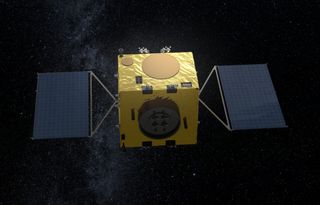A 'Self-Driving' Spacecraft May Help Save Earth from Asteroid Collisions
Europe's next asteroid mission, which could launch in 2023, will rely on the same kind of navigation technology as self-driving cars.
Named "Hera" after the Greek goddess of marriage, this proposed planetary defense mission would visit the 2,550-foot-wide (780 meters) asteroid 65803 Didymos and its tiny satellite, a 525-foot (160 m) object informally nicknamed "Didymoon."
While deep-space missions typically rely on controllers back on Earth to send navigation commands, Hera will have an automatic navigation system built in. This will allow Hera to steer itself in real time rather than waiting several minutes to receive a command signal sent from Earth.
Related: The Greatest Asteroid Encounters of All Time!
"If you think self-driving cars are the future on Earth, then Hera is the pioneer of autonomy in deep space," Paolo Martino, the lead systems engineer for Hera, said in a statement. Having an autonomous navigation system will enable the spacecraft to fly closer to both Didymos and Didymoon, which will allow it to take better high-resolution images of their surfaces, European Space Agency (ESA) officials said in the statement.
Much like a self-driving car, the Hera spacecraft will rely on data from sensors, cameras and lasers "to build up a coherent model of its surroundings," Jesus Gil Fernandez, a guidance, navigation and control engineer at ESA, said in the statement.

Hera won't be relying entirely on its autopilot for this first mission. The mission is still designed to be operated from the ground, and it won't start testing out the new system until all the mission's major objectives are complete, Fernandez said.
Get the Space.com Newsletter
Breaking space news, the latest updates on rocket launches, skywatching events and more!
Hera is one part of the larger Asteroid Impact and Deflection Assessment (AIDA) mission, which also includes a NASA spacecraft that will head to the same asteroid system. NASA's Double Asteroid Redirection Test (DART) mission aims to crash a spacecraft into the asteroid's surface, and the spacecraft will bring along two small cubesats that will examine the asteroid's surface.
While DART's mission is to smash into the asteroid, Hera's mission is to orbit the asteroid and observe the collision from a safe distance before swooping down to study the impact crater up close. The goal of the mission is to demonstrate a planetary defense strategy known as asteroid deflection. In other words, scientists want to figure out if it's possible to save Earth from a potentially catastrophic asteroid strike by launching a spacecraft at the asteroid to knock it off course.
- Humanity Will Slam a Spacecraft into an Asteroid in a Few Years to Help Save Us All
- To Nuke an Asteroid, How Powerful a Bomb Do You Need?
- Europe Plans Second Attempt at Asteroid Planetary Defense Mission
Email Hanneke Weitering at hweitering@space.com or follow her @hannekescience. Follow us on Twitter @Spacedotcom and on Facebook.
Join our Space Forums to keep talking space on the latest missions, night sky and more! And if you have a news tip, correction or comment, let us know at: community@space.com.

Hanneke Weitering is a multimedia journalist in the Pacific Northwest reporting on the future of aviation at FutureFlight.aero and Aviation International News and was previously the Editor for Spaceflight and Astronomy news here at Space.com. As an editor with over 10 years of experience in science journalism she has previously written for Scholastic Classroom Magazines, MedPage Today and The Joint Institute for Computational Sciences at Oak Ridge National Laboratory. After studying physics at the University of Tennessee in her hometown of Knoxville, she earned her graduate degree in Science, Health and Environmental Reporting (SHERP) from New York University. Hanneke joined the Space.com team in 2016 as a staff writer and producer, covering topics including spaceflight and astronomy. She currently lives in Seattle, home of the Space Needle, with her cat and two snakes. In her spare time, Hanneke enjoys exploring the Rocky Mountains, basking in nature and looking for dark skies to gaze at the cosmos.
